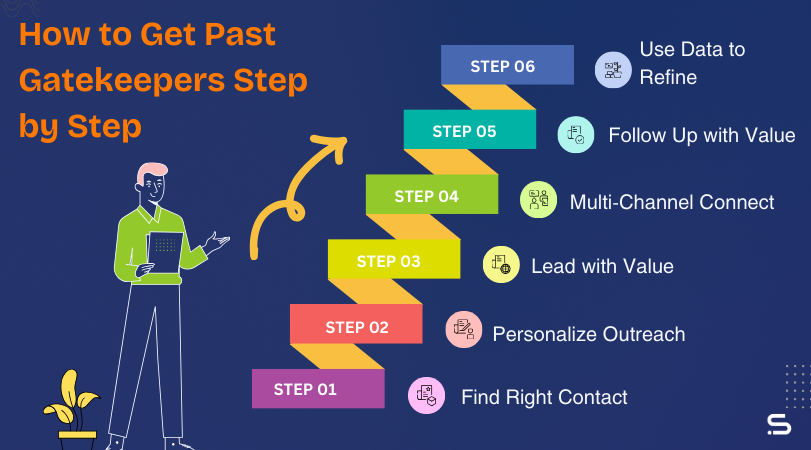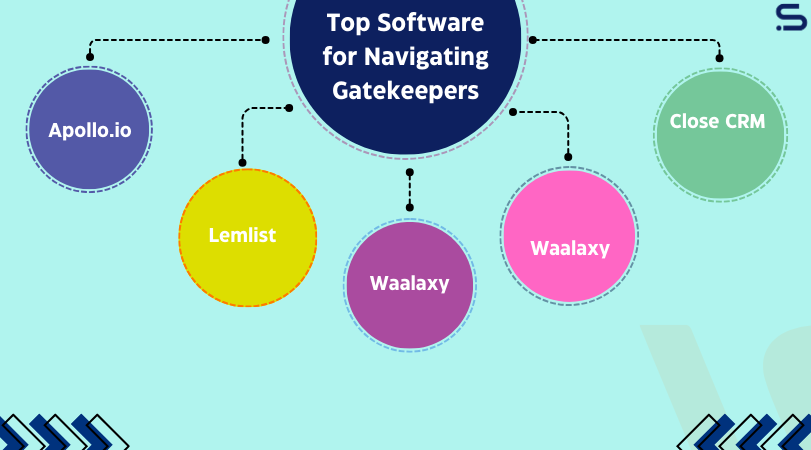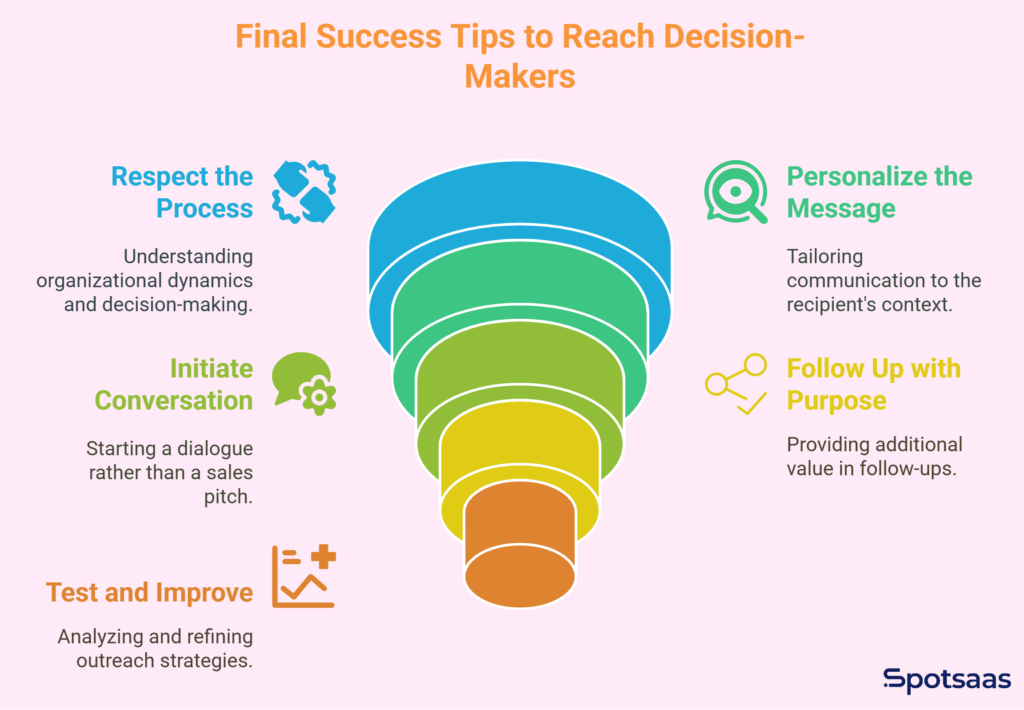You’re not getting ignored you’re getting blocked. Gatekeepers, whether human or automated, are trained to filter you out. But with the right strategy, you don’t need to push harder. You need to go smarter. This blog shows you how to reach decision-makers directly using tools and tactics that actually work.
We’ll cover what gatekeepers do, why your outreach isn’t breaking through, and how to stand out with messaging, channels, and software that give you a real edge. If you’re serious about getting in front of the right people, you’re in the right place.
Ready to unlock opportunities? Let’s dive in!
Key Takeaways
- Gatekeepers exist to filter access, not to hear your pitch.
- Reaching decision-makers requires research, not just volume.
- Personalized outreach beats generic messages every time.
- Multi-channel strategies (email, LinkedIn, video) get better results.
- The right tools can help you bypass blockers and scale smartly.
What Is a Gatekeeper?
A gatekeeper is anyone or anything that controls access to a decision-maker. Their role is to screen incoming messages, calls, or requests and decide what gets passed along and what gets ignored.
In modern outreach, gatekeepers can show up in different forms:
- Executive assistants who manage calendars and filter messages
- Junior staff who field calls and emails before forwarding them
- Automated email filters that flag cold outreach as spam
- LinkedIn limitations that prevent you from messaging non-connections
- Applicant tracking systems (ATS) that block your resume from human eyes
Whether human or digital, gatekeepers are designed to protect time — and unless your message feels relevant and credible, you’re likely getting filtered out.
Why Gatekeepers Block You (And What That Looks Like)
Gatekeepers aren’t out to sabotage you they’re protecting time, and they’re good at it. Whether human or automated, their job is to filter out anything that looks unimportant, unverified, or time-wasting.
If your outreach gets caught in that filter, you’ll never know it was blocked. Here’s how it happens.

Calls Sent to Voicemail
Phone calls from unknown numbers rarely make it through. If the gatekeeper doesn’t recognize your name or company, you’re sent straight to voicemail. Assistants are trained to screen calls by asking who’s calling and why, and if your reason isn’t clear or relevant, they won’t pass you through.
Sometimes, this isn’t even a person it’s a system set up to filter incoming calls. Cold calls with no context are easy to reject, especially when the caller sounds scripted or unsure. If you don’t sound like someone worth their time, the conversation ends before it begins.
Cold Emails Deleted on Arrival
Generic emails don’t survive long. Messages that sound templated, vague, or obviously automated are the first to go. Greetings like “Dear Sir/Madam” or “Hi there” scream mass outreach. Gatekeepers — and inbox filters — have seen every version of these.
If your message jumps straight into a pitch without showing relevance, it doesn’t get read. Decision-makers and their gatekeepers get dozens of cold emails daily. If yours doesn’t feel specific, thoughtful, and relevant, it’s deleted without a second thought.
Dumped into Generic Inboxes
Sending a message to info@ or contact@ feels like progress but it usually isn’t. These inboxes are flooded with unfiltered communication. They may be monitored by a gatekeeper or junior staffer, but there’s rarely a process for responding.
Even if your message is forwarded, it gets buried in threads or lost in volume. Unless you’ve built rapport or named a specific person, your message will likely sit unopened until it’s automatically archived or deleted.
Flagged by Spam Filters
You might be blocked before a person even sees your message. Many companies use spam filters or AI to scan emails for promotional language and suspicious formatting. Phrases like “act now,” “free trial,” or “limited time” are easy to detect and easy to flag.
Even excessive links, attachments, or subject lines with capital letters can trigger auto-filters. If your email looks like a marketing blast or has poor formatting, it won’t land in the primary inbox. It might not even land at all.
Resumes Rejected by ATS
If you’re applying for a job, a gatekeeper might not be a person — it’s software. Applicant tracking systems (ATS) scan resumes before a recruiter sees them. If yours is missing the right keywords, or if it’s formatted in a way the software doesn’t understand, it’s automatically filtered out.
This means qualified candidates often get rejected before a human ever looks at their application. Without optimization for these systems, you’re invisible to the people who make hiring decisions.
Ignored on LinkedIn
LinkedIn has its own gatekeeping system. If you’re not connected with someone, your messages often land in their “Message Requests” a section many users ignore. Decision-makers receive a flood of pitches, especially from people with no mutual connections.
LinkedIn also limits daily outreach and can restrict accounts that send too many unsolicited messages. Even if you write a solid message, if you’re a stranger with no context, you’re likely dismissed before being read.
How to Get Past Gatekeepers Step by Step
Reaching decision-makers is about clarity, timing, and the right tools. When you follow a focused strategy, you increase the chance your message gets noticed and responded to.

Step 1: Find the Right Contact
Before you reach out, make sure you’re targeting someone who can actually take action. Use tools and a bit of research to avoid wasting time on the wrong person.
Here’s how to do it effectively:
• Use LinkedIn to search by title and department
• Look for roles like Director, VP, or Head of [Function]
• Use Apollo, Lusha, or ZoomInfo to get direct contact details
• Confirm their relevance by checking recent activity or team info
When your outreach goes to someone with authority, everything that follows becomes more productive.
Step 2: Add Real Personalization
People respond to what feels relevant. A personalized message doesn’t just include a name. It references something that matters to them.
It could be a recent post they shared, a company announcement, or an article they were quoted in. That first personalized sentence builds trust and makes your message worth reading.
Step 3: Lead with Value
Start by focusing on what they care about, not what you’re selling. Share an idea, question, or quick insight that connects with their goals. Instead of saying “Can I book 15 minutes?” say something like “I noticed your team is expanding.
Here’s one thing that might make that easier.” Opening with value builds interest and sets you apart from typical outreach.
Step 4: Use Multiple Channels to Connect
Relying on one communication channel limits your visibility. A multi-channel approach builds familiarity and increases response rates.
Try this approach:
• Connect on LinkedIn and engage with their content
• Send a personalized email based on their role or activity
• Use video tools like Vidyard to add a face to your message
• If appropriate, follow up with a voice message or call
The more natural touchpoints you create, the more likely your message is seen and taken seriously.
Step 5: Follow Up With Value Each Time
Following up is not about reminding someone you exist. It is about giving them another reason to engage. Avoid repeating the same message. Instead, bring something new with each follow-up such as a relevant article, an industry trend, or a quick win from a similar company.
Spaced-out, thoughtful follow-ups keep you top of mind without being intrusive. People are busy. The right follow-up helps them see your message when the timing is right.
Step 6: Use Data to Refine Your Outreach
Track everything so you can improve with every campaign. Use tools like HubSpot, Mailshake, or Close CRM to monitor open rates, response rates, and follow-up performance.
Pay attention to what works such as subject lines, timing, or message structure and use that insight to adjust your outreach. Over time, you will build a repeatable system that brings better results with less guesswork.
Alternatives to Gatekeeper
While gatekeeper is a commonly used term, it can sometimes sound too harsh, confrontational, or repetitive especially in professional writing or outreach.
Choosing the right alternative can help you communicate more clearly, show respect for the person or system you’re addressing, and keep your content engaging.
Here are six of the best alternatives to gatekeeper, along with detailed explanations of how and when to use them.
Point of Contact
Point of contact is a professional and neutral term that refers to the person you initially reach out to within an organization. This could be someone who manages the inbox, directs phone calls, or coordinates first responses to inquiries. Using this term avoids conflict and keeps the tone collaborative.
It’s especially useful when you don’t want to imply that the person is blocking you, but rather managing communications as part of their role. In sales, hiring, or partnership conversations, referring to someone as the point of contact shows respect for their position without downplaying your intent to move forward.
Access Barrier
Access barrier is a functional term that focuses on the process rather than the person. It works well when you’re talking about systems, structures, or roles that slow or control access to decision-makers. This could include organizational hierarchy, security protocols, scheduling layers, or even geographic time zones.
It’s a great choice when writing analytically about business processes or when identifying the friction points in sales and outreach efforts. It also fits well in SaaS and operational content where efficiency, speed, and automation are key talking points.
Message Filter
Message filter is ideal when discussing how communications are screened before reaching their final destination. This could be an assistant reviewing emails, a spam filter using AI, or even a platform like LinkedIn deciding what shows up in someone’s inbox. It describes the role clearly someone or something is deciding what passes through.
This term is particularly useful in content that discusses digital tools, automation, or modern outreach challenges. It also helps frame your message strategy around making sure your communication feels valuable and relevant enough to be passed through the filter.
Screening Contact
Screening contact is a respectful and direct phrase that refers to someone who reviews and assesses messages before forwarding them on. It keeps the human element intact and acknowledges that this person has a task, not a grudge.
This term is useful when you’re writing about sales processes, especially in B2B, recruiting, or corporate sales contexts. It shows that you understand the structure of professional organizations and that you’re working with the process not trying to sneak around it. It positions the contact as part of the system, not an obstacle.
Front-Line Contact
Front-line contact refers to the first person you interact with in a communication flow. This could be a receptionist, customer support rep, junior executive, or virtual assistant. The term is neutral and approachable, often used in customer service or operational content.
It’s especially effective when writing about relationship-building strategies, because it reminds readers that every touchpoint matters — even if it’s not with the final decision-maker. Referring to someone as a front-line contact signals professionalism and shows that you understand the structure of client or partner communication.
Communication Gate
Communication gate is a softer alternative to gatekeeper that still acknowledges the presence of a controlled access point. It works well in both human and automated contexts.
For example, an assistant managing a calendar or an email spam filter can both be described as a communication gate.
This term focuses on the system rather than blaming the individual. It’s ideal for SaaS or marketing content where you’re explaining how to optimize outreach, improve deliverability, or structure messaging for better access. It invites readers to think about how to open the gate, not break it down.
Top Software for Navigating Gatekeepers
Reaching decision-makers often comes down to how you manage the gatekeepers along the way. Whether that gatekeeper is a person, a system, or a process, the right software can help you break through more consistently.

These tools assist with finding the right contacts, crafting relevant outreach, and ensuring your messages actually land where they need to. Instead of getting stuck in generic inboxes or lost in filters, you gain direct visibility and control over your outreach.
Below is a list of the most effective software to support your outreach and help you connect with the people who matter most.
| Tool | Main Use | Starting Price | Best For | Key Feature |
|---|---|---|---|---|
| Apollo.io | Lead discovery and outreach sequences | Free to $99/month | Sales teams, recruiters | Verified emails and contact enrichment |
| Lemlist | Personalized cold email campaigns | $39/month | SDRs, agencies, consultants | Dynamic image and video personalization |
| Waalaxy | LinkedIn automation and lead engagement | Free to $80/month | Freelancers, small teams | Multi-step messaging on LinkedIn |
| Vidyard | Video messages for email and LinkedIn | Free to $19/month | Outbound reps, founders | One-to-one video recording and tracking |
| Close CRM | CRM with calling and email integration | $99/month | Sales teams managing pipelines | Combined outreach, tracking, and CRM |
Final Success Tips to Reach Decision-Makers
The strategies and tools you’ve seen throughout this guide can open doors, but consistent success depends on how well you apply them.
Getting past gatekeepers is not just about what you send, but how you think about outreach, how you build relationships, and how you adapt. These final tips bring all the pieces together to help you communicate with confidence and clarity.

Respect the Process Without Rushing It
Gatekeepers and internal processes exist to protect time and focus. Trying to skip steps or use tricks can damage your credibility. Instead, take time to understand how the organization operates.
Ask yourself what the right contact would need to see before engaging. Align your outreach with how they make decisions and when they make time for external messages. Respect earns attention. People notice when you approach them with professionalism and patience.
Personalization Is Always Worth the Extra Minute
Generic messages get skimmed or ignored. Personalization tells the recipient you’ve made an effort. It signals that your message is relevant, timely, and thoughtful.
This doesn’t mean rewriting every email from scratch, but it does mean including something specific to the person you’re contacting. Mention a recent event, project, or quote.
Reference something meaningful from their website or social presence. Even one sentence of personalization can double your chances of a reply. It turns your message into something human.
Use Outreach as a Conversation Starter
Many outreach messages fail because they push too much, too soon. Your first contact should not feel like a pitch or a request for time. It should feel like an introduction or an opening line to a useful exchange.
Offer something small but valuable. Ask a question that sparks curiosity. Make it clear that your message is the start of a conversation, not a one-sided sales attempt. Decision-makers are more willing to respond when there is no pressure attached to the first reply.
Follow Up with Purpose
No response does not mean no interest. Most people are busy, and messages slip through. That is why your follow-up should never feel like a reminder. It should add something new.
Each follow-up is another chance to provide value. Share a relevant article, a brief case study, a new insight, or even a revised version of your original idea. Keep it short, focused, and respectful of their time. When done well, follow-up messages show consistency, not desperation.
Keep Testing and Improving
Success in outreach is not just about effort. It is about learning what works and improving your approach over time. Use outreach tools and CRM platforms to track open rates, response times, and conversion steps.
Look at which subject lines get attention and which messages lead to replies. Small changes in tone, timing, or formatting can have a major impact. The more you analyze your results, the more confident you become in what works. Growth comes from feedback and iteration.
Conclusion
Getting past gatekeepers isn’t about tricks. It’s about reaching the right people with purpose, using smart tools, and leading with value. Whether you’re in sales, recruiting, or partnerships, strategy matters more than volume.
With the right approach, personalized outreach, and consistent follow-up, you won’t just get through gatekeepers — you’ll get noticed by decision-makers. The next move is yours.
Start with one message, track what works, and improve with every send. Real results come from thoughtful action, not guesswork.
FAQs
What is a gatekeeper in sales or outreach?
A gatekeeper is anyone or anything that controls access to a decision-maker. This can be a human, such as an executive assistant, or a digital system like an email filter or ATS.
How can I get past gatekeepers without sounding pushy?
Use personalization, lead with value, and speak clearly to their role. Show respect, avoid pressure, and focus on starting a conversation, not making a hard pitch.
What tools help with reaching decision-makers directly?
Tools like Apollo.io, Lemlist, Waalaxy, Vidyard, and Close CRM help you find contacts, send personalized outreach, track performance, and manage follow-ups effectively.
How many follow-ups should I send?
Most effective outreach includes 3 to 5 follow-ups. Each should add value or a new angle, not just repeat your original message. Timing and content matter more than frequency.
Can I bypass gatekeepers completely?
In many cases, yes. With the right research, tools, and messaging, you can often connect directly with decision-makers via email, LinkedIn, or referrals — but it must be relevant and respectful.




